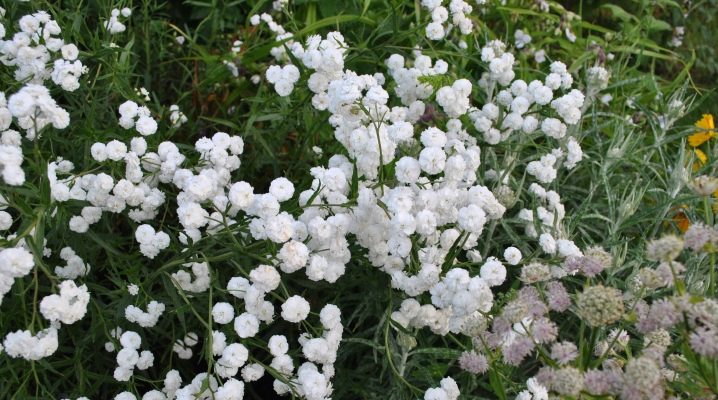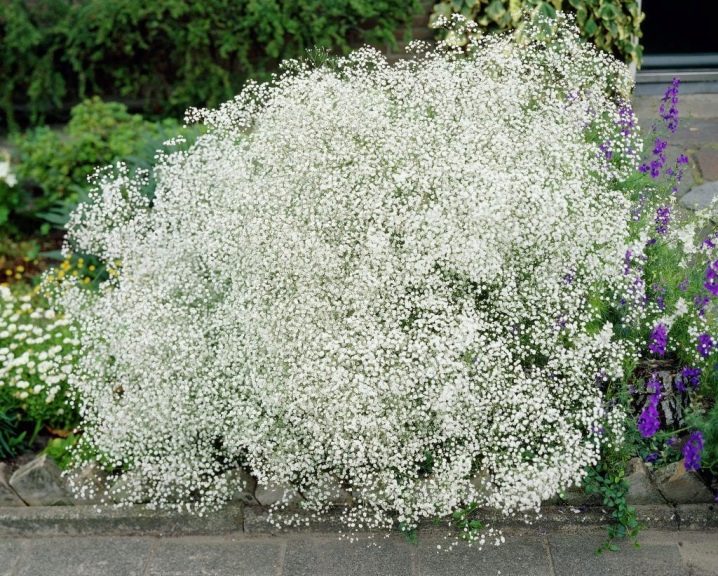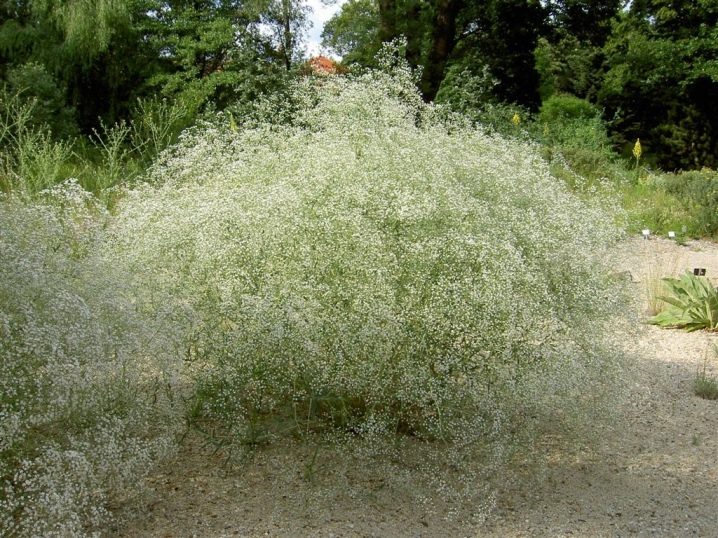Gypsophila paniculata and features of its cultivation

Gypsophila is a herbaceous spherical shrub of the Clove family. About 100 plant species of this culture are known. They have different colors, can be perennial and annual. Gypsophila paniculate is also represented by several subspecies. In the descriptions, you can find other plant names: swing paniculata, tumbleweed, gypsum lover.

Description
Gypsophila translates as "love for plaster." The name itself speaks of the growth of these plants on limestone soils. The swing paniculata species is the most common gypsophila culture and is less dependent on limestone, but also prefers arid soils: steppes, rocky areas, dry hills and meadows. Gypsum lover can be found in Central and Southern Europe, Central Asia, Siberia, North America.

Externally, the gypsophila paniculata with its grace and ease resembles a magnificent wedding dress or a bridal bouquet, consisting of many exquisite small flowers, collected on thin branches in a weightless ball. The branches give a round shape to the plant, which rush from the root trunk in different directions and actively branch. They can form a ball up to 120 cm in diameter. Small flowers of white, pink, lilac, bluish color generously shower the bush, creating the image of an airy lace or veil.

In the steppes, you can often find a similar ball, driven by a dry wind across the entire field. Watching its rolls, it becomes clear why the people called the plant tumbleweed. The young swing paniculata firmly holds the ground with its roots. When the seeds ripen, the basal stem dries up and the wind easily tears the plant off its home. Traveling across the steppe, gypsophila scatters seeds everywhere, giving the opportunity for new seedlings to appear.

Kachim paniculata refers to perennials, in terms of landscape design it will not have to be planted every year. Round-shaped herbaceous shrub grows in diameter from 60 to 120 cm.
Let's consider other features of culture.
- Stems. Erect stems start from the basal base, during growth they branch strongly, forming a ball. Flexible greenish-gray branches are often devoid of leaves and are covered with short bristles at the base. The length of the branches is 50-100 cm.

- Shoots. The branches give numerous young shoots of a greenish tint with slight pubescence. Paniculate inflorescences are formed on them.

- Root system. The plant forms a strong taproot that goes deep into the soil up to almost a meter. The wind, tearing off the dry bush, cannot damage the root system, which allows a new ball to form the next year.

- Leaves. Long lanceolate leaves are slightly pubescent, have the following dimensions: length - maximum 7 cm, width - not more than 1 cm. Depending on the subspecies, they can have a different color: juicy fresh greens, whitish, gray-green.

Some varieties of gypsophila are extremely rarely covered with leaves, but there are also those that, in terms of the activity of the cover, compete with the flowers of the plant.
- Inflorescences. Inflorescences form a non-leafy loose paniculate raceme located on a thin peduncle. On average, the panicle grows up to 6 cm and is several times longer than the sepals.

- Flowers. The formula of the flower structure is as follows: the calyx (1.5 mm) in the shape of a bell contains 5 petals from 1 to 3 cm long. In the center of the calyx there are 10 stamens.The flowers are heterosexual, since the plant is self-pollinating. The priority is the white color of the petals, but there are other shades. Beautiful decorative terry varieties have been bred.

- Fruit. A mature flower forms a nesting achene ball. Drying, the box spontaneously opens and releases the contents. Seed material of gypsophila is capable of sprouting for three years.

The plant blooms from 40 to 60 days. Depending on the variety and region, flowering can be expected between July and September. In garden conditions and with proper care, they often achieve a longer flowering period, stretched over the whole summer.
Unusual plant balls in the steppe were noticed by people for a long time. Since the 18th century, they tried to use kachim as a detergent. The roots, due to the presence of a large amount of saponins, formed a persistent foam during whipping, in which fine wool and delicate fabrics were washed.

Today, farmers resort to gypsophila, planting it on dry, mobile soils in order to fix them.
But Most of all, we swing paniculata is used in bouquets as a background for more lush and bright flowers: roses, lilies, chrysanthemums. The delicate elegant balls are also loved by landscape designers, planting them with single bushes or in compositions with other dry-loving plants.


Popular varieties
Gypsophila paniculata has many varieties, therefore it is found in different sizes, shapes and colors. It was this species that was taken as the basis for the breeding of terry varieties with large fluffy flower heads. But plants with small flowers, densely scattered over the surface of the bush, are not inferior in beauty, they look like a smoky veil or a refined cobweb.
Any of the subspecies of paniculata kachima is beautiful in its own way.
- Pink Star. Shrub 60-120 cm high is distinguished by pink double flowers. Grows on sandy-loamy soils, frost-resistant. Flowering occurs from July to August for 45 days. Loves open, sunny places. It dies from an excess of moisture.

- Summer Sparkles. Depending on the growing conditions, the plant can be compact (40-60 cm) or form into giant bushes up to 120 cm. Five-petal flowers are pure white, but you can also find options with a slight pink tint. For cultivation, you need a drainage system, limed or clay-sandy soil.

- Flamingo. Terry decorative variety is considered as the leading one in beauty and scale among paniculata kachim. The palette of colors is pink, from pale to rich shades. A perennial bush of this subspecies can grow up to 140 cm in diameter. It contains a dense cover of both leaves and inflorescences. Blooms throughout the summer.

- "Snow flakes". An openwork variety of gypsophila paniculata in shape is close to a ball. It has branched shoots with an abundance of snow-white double flowers. The shrub grows up to a meter in diameter, blooms from early June to late August. Poorly transplantable. If the plant is not disturbed, it can grow for over 20 years without changing its location.

- White Fleur Festival. The variety is endowed with large flowers. A short bush (up to 50 cm) with a powerful root system looks especially decorative during flowering (July-August), when it is completely covered with snow-white "cotton" inflorescences. Resistant to drought and frost, without transplanting it can grow up to 9 years.

- Rosenschleier. The variety is a hybrid of gypsophila paniculata and gypsophila creeping, therefore it has a small height - 40-50 cm, but at the same time it spreads over the soil in a wide ball. The bush contains double pink flowers 6 mm in diameter, which delight with their beauty throughout the summer.

Cut branches preserve the beauty of blooming brushes in a dried form, therefore the Rosenschleier variety is used in winter and summer bouquets.
- Bristol Fairy. A beautiful spherical bush with a diameter of 90-100 cm is strewn with large white double flowers.It has long, narrow-lanceolate leaves of a gray-green hue, blooms from July to August.

- Snowflake. An openwork bush grows up to a meter in diameter. It contains small (5 mm) flowers, but their splendor and dense cover make the plant cottony-airy. It blooms from mid-summer to early September, for a total of about two months. Prefers soils with high water permeability, does not tolerate the proximity of groundwater.

Landing
You can plant gypsophila paniculata with seeds, cuttings, layering. The seeds are used to obtain seedlings in greenhouse conditions (in boxes), which are subsequently transplanted onto a land plot. The cuttings method also requires greenhouse cultivation in containers. They work with layering on open ground, without preliminary germination. Let's take a closer look at the seed growing method.


Preparation
To grow seedlings from seeds, it is necessary to prepare a room in which the temperature regime will be observed at the level of 20-25 degrees. Gypsophila develops well under the condition of daylight hours lasting at least 12 hours.
If the daylight hours are shorter in March, it should be supplemented with artificial lighting. For this, phytolamps are prepared in advance.
Deep boxes are made for seedlings. The soil is prepared alkaline or neutral, with the addition of compost and sand. If the soil is acidic, work on it: add lime, chalk or dolomite flour to the composition. At the bottom of the box, a drainage cushion of pebbles, sand, and broken brick is laid. It helps moisture not to stagnate in the soil. Then the soil is poured, lightly rammed and watered from a spray bottle.

Sowing seeds
In boxes with soil, rows of grooves are made with a step of 7 cm, deepening into the soil by 5 mm. Seeds are laid out in the grooves, lightly sprinkled with earth and irrigated with a spray bottle. Then the boxes are covered with polyethylene or glass and placed on the windowsill. Once a day, the crops should be ventilated for 10-20 minutes, removing the polyethylene. Watering after the soil has completely dried out, but in the created greenhouse conditions this does not happen often. When the seedlings rise 1-2 cm, the cover glass is removed. In greenhouse conditions, the seeds are sown in early spring. By the end of May, the grown seedlings are transplanted to the site.
You can sow seeds directly into open ground. Such sowing is carried out in the fall. In the spring, after the seeds awaken, the bed is covered with polyethylene, creating a special microclimate. When the ambient temperature is warm (at night not less than +12 degrees), and the seedlings rise by 2-4 cm, the polyethylene can be removed.

Planting seedlings in open ground
For seedlings on the site, an open, sunny place should be prepared. The soil should be sandy loam, light, neutral or with a minimum level of acidity.
You cannot plant a swing in a lowland where melt water collects, or where groundwater lies close to the surface, since gypsophila is a dry-loving plant with a root system deeply embedded in the soil.
Seedlings are planted in May according to the scheme of 50x70 cm with a 2-3 cm deepening into the soil. Do not sprinkle the root collar with earth, otherwise the plant may die. After 2-3 years (no later!), The grown-up swing must be planted, leaving each bush at least 1.5 m of free space. An adult plant acquires a long, solid root and does not tolerate a change in place.

Care
Although gypsophila paniculata is not particularly capricious, you still have to take care of it if you want to get a good result.

Seedlings are grown from March to May, carrying out the following care steps during this period.
- The earth is watered as it dries.
- After 3 weeks after seed germination, the seedlings are thinned out, leaving only strong plants. The distance between them should be 15 cm.
- 20 days before planting seedlings in open ground, they begin to harden it. To do this, a box with plants is taken out into the street in the daytime, and returned to the room at night.It is necessary to start adaptation from 1 hour of the seedlings stay in the fresh air, daily the time of "walks" increases by half an hour.
- You can plant on the site those plants that already have 2-3 developed leaves.

When there was a transplant in open ground, the plant is taken care of in the following way.
- Watering should be less than moderate. Kachim tolerates a slight lack of moisture more easily than diluting dampness.
- Spring feeding usually contains mineral nitrogenous fertilizers. In the fall, rotten manure and compounds with potassium and phosphorus are added to the soil.
- In winter, the plant is cut, leaving a stem 4-7 cm high, then mulched and covered with spruce branches.
- If the stems are pinched during the summer, a lush, rounded bush will develop.



Reproduction methods
In addition to seed, there are other ways of reproduction of gypsophila.
- Cuttings. The method is good for terry varieties. Cuttings are obtained from young shoots cut before flowering. Further, the twigs are grown in boxes under a film in greenhouse conditions.
- Layers. When pruning a bush, several branches are left at the root, laid horizontally on the ground and sprinkled with soil. In spring, the cuttings take root and young shoots germinate.


Diseases and pests
Kachim rarely gets sick, but with poor care it can suffer from pests and putrefactive lesions. One should watch out for the following troubles.
- Gray rot. They fight with Fitosporin-M and Bordeaux liquid.
- Miner moth. Destroys shoots quickly.
- Rust. Sick bushes are treated with Topaz and Oxyhom.
- Nematodes. These are worms that destroy the leaves of the plant. Washing the bush with hot water helps from them.


Application in landscape design
Gypsophila paniculata in gardens is planted singly or in mixborders with other dried flowers. It can serve as a background option for large flowers, not only in cut bouquets, but also growing in a flower bed, in rockeries, rabatkas, rock gardens.













The comment was sent successfully.